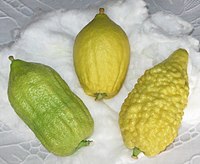Pompia
| Pompia | |
|---|---|

| |
| Pompia fruit | |
| Scientific classification | |
| Kingdom: | Plantae |
| Clade: | Tracheophytes |
| Clade: | Angiosperms |
| Clade: | Eudicots |
| Clade: | Rosids |
| Order: | Sapindales |
| Family: | Rutaceae |
| Genus: | Citrus |
| Species: | |
| Variety: | C. m.var.tuberosa
|
| Trinomial name | |
| Citrus medicavar.tuberosa Risso(1813)
| |
| Synonyms | |
| Citronvarieties |
|---|
 |
| Acidic-pulp varieties |
| Non-acidicvarieties |
| Pulpless varieties |
| Citronhybrids |
| Related articles |
Pompia(Citrus medicavar.tuberosa), also calledpumpia,sa pompia,spompia,andChina citron,is aCitrushybridcultivated for its ediblefruit.[1]It is a taxonomical synonym ofCitrus medica.[2]
Distribution
[edit]Pompia originated and is found only inSardinia,especially the eastern half, where it can be found growing wild incitrusgroves and cultivated in backyards and orchards.[3]The earliest descriptions of it date back to 1780 and it likely originated around 1760 inMilis.[4]
Description
[edit]
Thefruitis moderately large (at least as large as agrapefruit), round and sometimesoblateor square in shape, and has a rough, warty, yellow (green when unripe), thick, and sometimes ribbedrind.It sometimes has a circular depression in the top or bottom. The inner pulp is acidic, yellow, and mostly dry and is generally considered inedible;[5]it has been described as bitter and chewy. It has a subtle fragrance and contains 13–14 wedges with largevesicles.It is usually seedless but may contain one to threepolyembryonicseeds which measure 8 to 12 millimeters (0.31 to 0.47 inches) in length and are roughly triangular in shape. It weighs up to 1.5 pounds (0.7 kilograms). The tree is densely branched and grows 2 to 3 meters (6.6 to 9.8 feet) in height and has an expanded and erect posture. Thepetioleis unwinged and measures 6–10 millimeters in length. The leaves areellipticalin shape and are dark green in color; they are leathery and theapexis rounded in anovatetolanceolateshape. Themarginisentireand themidribis very defined. Theflowersare white in color and are either solitary or in clusters of two to eight; they usually have fivepetals.They have numerousstamensanddorsifixedanthers,and thestigmais round and green in color and irregularly lobed. The tree fruits from October to February or March.[4]
Uses
[edit]
The fruit has been grown and cultivated for at least two centuries inSardinia;however, it did not gain international popularity until the 1990s, when a large orchard of pompia trees were planted as part of a social farming project. Since then, it has become a presidium ofSlow Food.[6]It is most notably used insa pompia intrea,a traditional dessert ofSiniscolain which the rind of the fruit is candied and then covered with honey and served on an orange leaf. It is also used in variousliquors[7]and is sometimes grafted ontosour orange.[4]
Genetics
[edit]Before the parentage was confirmed, the pompia was thought to be a hybrid of acitronandgrapefruitor citron andlemon;however, recent studies have proven the pompia to be a hybrid of the citron (Citrus medica) and thesour orange(Citrus aurantium), with the citron being the pollen parent and the sour orange being the seed parent. The variety of the citron parent has not been confirmed, but it is likely aDiamante citronor a common poncire. The pompia is genetically synonymous with theRhobs el Arsaand Poncire de Collioure citrons. Theessential oilcomposition in the leaf is closer to that of a citron, while the essential oil composition in the zest is closer to that of a sour orange.[1]The major compound in the fruit islimoneneat 94%, and it contains smaller amounts ofsesquiterpenesand its derivatives.[8]The rind of the fruit containsantioxidantsubstances[9]and the leaves containantimicrobialsubstances that killListeriabacteria on foods.[10]
See also
[edit]References
[edit]- ^abLuro, François; Viglietti, Grazia; Marchi, Elodie; Costantino, Gilles; Scarpa, Grazia Maria; Tomi, Felix; Paoli, Mathieu; Curk, Franck; Ollitrault, Patrick (1 December 2019)."Genetic, morphological and chemical investigations reveal the genetic origin of Pompia (C. medica tuberosa Risso & Poiteau) – An old endemic Sardinian citrus fruit".Phytochemistry.168:112083.doi:10.1016/j.phytochem.2019.112083.PMID31521382.
- ^"Citrus medica var. tuberosa Risso".gbif.org.Retrieved23 September2023.
- ^"Pompia - Presidi Slow Food".fondazioneslowfood.Retrieved26 January2021.
- ^abcViglietti, Grazia (2015–2016).Morphological, chemical and genetic characterization of Citrus monstruosa, an endemism of Sardinia(Thesis).Retrieved14 February2021.
- ^"Pompia - Presìdi Slow Food".Slow Food Foundation.Retrieved26 January2021.
- ^"Pompia Citron".Oscar Tintori - Nurseries Worldwide - Citrus Plants.Retrieved26 January2021.
- ^"pompia citrus monstruosa".sandalyon.eu.Retrieved26 January2021.
- ^"The origins of pompia: An Italian citrus delicacy".Wiley Analytical Science.doi:10.1002/sepspec.152124807a4(inactive 31 January 2024).Retrieved26 January2021.
{{cite web}}:CS1 maint: DOI inactive as of January 2024 (link) - ^Manconi, Maria; Manca, Maria Letizia; Marongiu, Francesca; Caddeo, Carla; Castangia, Ines; Petretto, Giacomo Luigi; Pintore, Giorgio; Sarais, Giorgia; D'hallewin, Guy; Zaru, Marco; Bacchetta, Gianluigi; Fadda, Anna Maria (15 June 2016)."Chemical characterization of Citrus limon var. pompia and incorporation in phospholipid vesicles for skin delivery".International Journal of Pharmaceutics.506(1–2): 449–457.doi:10.1016/j.ijpharm.2016.04.014.PMID27084291.Retrieved26 January2021.
- ^Fancello, Francesco; Petretto, Giacomo L.; Marceddu, Salvatore; Venditti, Tullio; Pintore, Giorgio; Zara, Giacomo; Mannazzu, Ilaria; Budroni, Marilena; Zara, Severino (May 2020)."Antimicrobial activity of gaseous Citrus limon var pompia leaf essential oil against Listeria monocytogenes on ricotta salata cheese".Food Microbiology.87:103386.doi:10.1016/j.fm.2019.103386.PMID31948627.S2CID210703054.Retrieved26 January2021.
